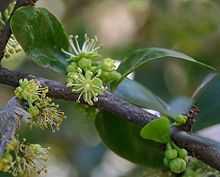Dovyalis
| Dovyalis | |
|---|---|
 | |
| Dovyalis caffra | |
| Scientific classification | |
| Kingdom: | Plantae |
| (unranked): | Angiosperms |
| (unranked): | Eudicots |
| (unranked): | Rosids |
| Order: | Malpighiales |
| Family: | Salicaceae |
| Tribe: | Flacourtieae[1] |
| Genus: | Dovyalis E.Mey. ex Arn. |
| Species | |
|
About 15 species, including: | |
| Synonyms | |
|
Aberia Hochst. | |
Dovyalis is a genus of shrubs and small trees. Recent genetic evidence has shown the genus to belong to the family Salicaceae; formerly it was classified in the family Flacourtiaceae. The 15 species are native to Africa (Ethiopia south to South Africa) and southern Asia (India, Sri Lanka).
They are dense, thorny plants growing to 3–6 m tall, with sharp, 3–6 cm long stem spines in the leaf axils. Buds at the base of the spine produce clusters of alternately arranged simple ovate leaves 3–10 cm long.
The flowers are inconspicuous, solitary or clustered, with no petals. They are dioecious, with male and female flowers on separate plants. The fruit is an edible, yellow to purple globose berry 2–4 cm diameter, containing several small seeds. They are very juicy and with an acidic flavour.
Cultivation and uses
Several species are grown for their fruit; D. caffra (Umkokola or Kei-apple) is popular in southern Africa, and D. hebecarpa (Kitembilla) in India and Sri Lanka. Some, notably D. abyssinica, are also grown as ornamental plants and as hedges, where the spines are valued for deterring intrusion by livestock or burglars.
A hybrid between D. hebecarpa and D. abyssinica was developed in Florida in 1953, and is known as Tropical Apricot or Ketcot.[2]
References
| Wikimedia Commons has media related to Dovyalis. |
| Wikispecies has information related to: Dovyalis |
- ↑ "Genus Doyvalis". Taxonomy. UniProt. Retrieved 2010-02-03.
- ↑ Love K, Bowen R, Fleming K. (2007). "Twelve Fruits with Potential Value-Added and Culinary Uses". Honolulu (HI): University of Hawaii.